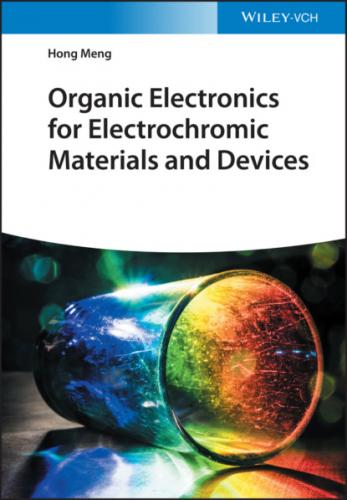6 Chapter 6Figure 6.1 Structure of common aromatic molecules utilized in electrochromic...Figure 6.2 Diagrams of doping process for polythiophene, polypyrrole, and po...Figure 6.3 (a) Electronic band evolution for nondegenerate ground‐state conj...Figure 6.4 Investigations on the electrochemical process of P3HT.Figure 6.5 Synthesis of thiophene‐based homopolymer and copolymer via oxidat...Figure 6.6 Examples for copolymerizing ECPs via Suzuki (upper) or Stille (do...Figure 6.7 Diagrams for research works employing DHAP.Figure 6.8 Commonly utilized building blocks for thiophene‐based electrochro...Figure 6.9 Effect of interring strain.Figure 6.10 Steric strain‐increasing or relaxing strategy.Figure 6.11 Effect of bulky side chains.Figure 6.12 Progress of yellow and orange ECPs.Figure 6.13 Typical example of red ECPs.Figure 6.14 Molecular structure, diagram, and photography of electrochromic ...Figure 6.15 Device or processing developed based on magenta ECPs.Figure 6.16 Molecular structure and displayed color changes of thiophene‐bas...Figure 6.17 Multicolored electrochromisms. Source: Reproduced with permissio...Figure 6.18 Green to soil‐like colored materials and relative devices.Figure 6.19 Triarylamine‐based anodic electrochromic polymers.Figure 6.20 Chemical structure of the monomers 3‐ETSNa and 3‐BTSNa.Figure 6.21 (a) Chemical structure of the polymers. (b) Concentrated water s...Figure 6.22 Chemical structure of the polymers P2 and P3 and the correspondi...Figure 6.23 Figure 6.23 Square‐wave potential‐step chronoabsorptometry of (a)...Figure 6.24 Chemical structure of the polymer P4 and the corresponding polym...Figure 6.25 General overview of the conversion of an organic soluble polymer...Figure 6.26 (a) Spectra recorded in 50 mV increments from −0.80 to +0.70 V v...Figure 6.27 Electrochromic properties of water‐processable ProDOT derivative...Figure 6.28 Solubility tuning of ProDOT with four‐ester functional side chai...Figure 6.29 Proposed mechanism for electropolymerization of pyrrole by Diaz ...Figure 6.30 Electronic energy diagrams and structures for (a) neutral PPy, (...Figure 6.31 Electrochromism of polypyrroles.Figure 6.32 Technology development of polypyrrole derivatives.Figure 6.33 Chemical structure of N‐substituted polypyrrole derivatives.Figure 6.34 Color changes and the optical contrast of polymer PPy6 at differ...Figure 6.35 (a) Color changes of polymers PPy17, PPy18, PPy19, and PPy20. (b...Figure 6.36 (A) Spectroelectrochemistry of PEDOP in 0.1 M LiClO4/PC at appli...Figure 6.37 Completing the puzzle. Shown in blue, the N‐substituted PXDOP fa...Figure 6.38 Chemical structure of 3,4‐substituted polypyrrole derivatives.Figure 6.39 UV/vis–NIR transmittance spectra for the neutral (a), intermedia...Figure 6.40 Chemical structure of D–A type polypyrrole derivatives and the e...Figure 6.41 Chemical structure of polypyrrole‐based terarylene systems.Figure 6.42 Mechanisms of electrochemical oxidation of carbazole. Cyclic vol...Figure 6.43 Technology development of polycarbazole derivatives.Figure 6.44 (a) A segment of poly(carbazole‐co‐phenylene) depicting (1) neut...Figure 6.45 Spectroelectrochemical spectra and colors of (a) PCz6 (0.4–1.35 ...Figure 6.46 (a) Colorimetric data for polymers PCz13, PCz14 and PCz15.(b...Figure 6.47 Electronic absorption spectra and the colors of polymer PCz17 on...Figure 6.48 (a) Electronic absorption, transmittance behaviors, and colors o...Figure 6.49 Cyclic voltammograms and color changes of (a) PCz25, (b) PCz26, ...Figure 6.50 Chemical structure of linear polycarbazole derivatives.Figure 6.51 Figure 6.51 Spectroelectrochemical spectra and colors of (a) PCz1...Figure 6.52 Figure 6.52 Spectroelectrochemical spectra and color changes of (...Figure 6.53 (a) Spectroelectrochemical spectra of PCz37 between −0.3 and + 1...Figure 6.54 UV–visible absorption spectra of (a) PCz39 and (b) PCz40 films o...Figure 6.55 UV–visible absorption spectra of (a) PCz42 and (b) P(tnCz1–bTp2)...Figure 6.56 Electropolymerization of (a) NO2–3Cz and (c) NH2–3Cz. Spectroele...Figure 6.57 Figure 6.57 Spectroelectrochemical spectra and color changes of (...Figure 6.58 Chemical structure of cross‐linked polycarbazole derivatives.
7 Chapter 7Scheme 7.1 Chemical structures of some typical commercialized PIs and PAs.Scheme 7.2 Chemical structures of the first TA‐based polyimides and TA‐based...Figure 7.1 Cyclic voltammetric diagrams of the first EC PI and its EC behavi...Scheme 7.3 The oxidation pathways of MV class I–III monomers.Figure 7.2 Absorption spectral change of MV class I–III compounds at various...Figure 7.3 Development of TA‐based electrochromic PIs/PAs.Scheme 7.4 The oxidation process of TPA and the reaction scheme of unstable ...Scheme 7.5 TPA‐based polyamides with protecting groups.Figure 7.4 The cyclic voltammetric diagram and color changes in electrochemi...Scheme 7.6 Introduction of increased electroactive groups towards multiple c...Figure 7.5 Electrochromic behavior of multiple color PI 2a and PI 2b thin fi...Figure 7.6 Electrochromic behaviors of the NIR EC PIs/PAs with pendant group...Scheme 7.7 Chemical structures of EFC TA‐based PIs/PAs by introduction of lu...Figure 7.7 EC properties of CN‐PA/CN‐PI and EFC behavior of CN‐PI.Scheme 7.8 Chemical structures of polyimides with dual functions of memory a...Scheme 7.9 Novel multifunctional polyimides with multiple stimuli‐responsive...Scheme 7.10 Typical multiple color PIs/PAs with increased electroactive TPA ...Figure 7.8 (a) Cyclic voltammograms of polyamide PA 11 film onto an indium t...Figure 7.9 TA‐based black‐to‐transmissive EC copolymer (A) and EC devices co...Scheme 7.11 TA‐based EC poly(amide‐imide)s.Scheme 7.12 TA‐based EC poly(ether‐imide)s and poly(ether‐amide)s.Scheme 7.13 TA‐based EFL polyamides with cycloaliphatic (PA 12a) and aromati...Figure 7.10 (a) Electrochromic behaviors of EC polyimides PI 8a and (b) devi...Scheme 7.14 TA‐based high‐contrast‐ratio EC PIs with alicyclic nonlinear dii...
8 Chapter 8Figure 8.1 Electronic transitions in transition metal complexes.Figure 8.2 (a) A possible mechanism for the electrochromic change in Fe‐base...Figure 8.3 (a) The molecular structure of ligand bis(terpyridine)s and the p...Figure 8.4 Preparation of the Fe(II)‐based metallo‐supramolecular polymer wi...Figure 8.5 Illustration of the 3D structure metallo‐supramolecular polymer....Figure 8.6 (A) Molecular structure of CoII–bis‐terpyridine metallo‐supramole...Figure 8.7 (A) Molecular structure of ZnII‐based metallo‐supramolecular poly...Figure 8.8 (a) Synthetic route of CuI–o‐phenanthroline metallo‐supramolecula...Figure 8.9 (A) Molecular structure of Eu(hfa)3(H2O)2 and HV2+ and corres...Figure 8.10 (A) Molecular structure of heterometallo‐supramolecular polymers...Figure 8.11 (a) Formation of ruthenium‐based monolayers on ITO‐coated glass....Figure 8.12 Molecular structure of electropolymerizable monomer.
9 Chapter 9Figure 9.1 The roadmap of EC MOFs and EC COFs.Figure 9.2 The synthesis of the simulated structure of Zn(NDI‐H), Zn(NDI‐SEt...Figure 9.3 The color changes and the corresponding voltages of Zn(NDI‐H), Zn...Figure 9.4 (a) Synthesis and simulated structure of M‐NDISA. Spectroelectroc...Figure 9.5 (a)
